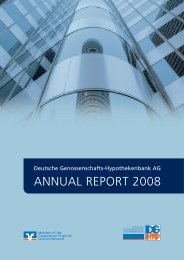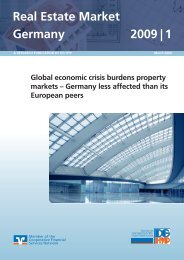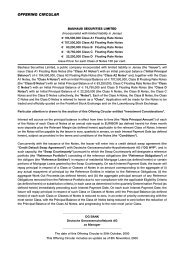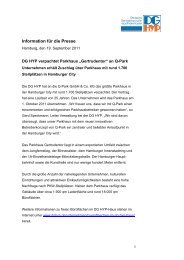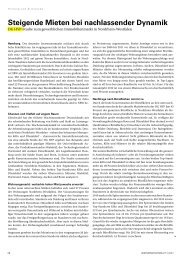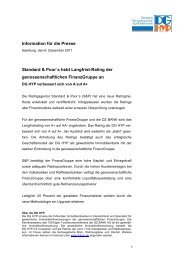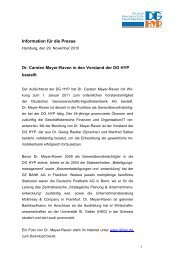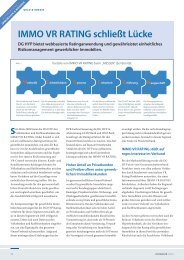Covered Bonds - DG Hyp
Covered Bonds - DG Hyp
Covered Bonds - DG Hyp
Create successful ePaper yourself
Turn your PDF publications into a flip-book with our unique Google optimized e-Paper software.
<strong>DG</strong> HYP COVERED BONDS – PFANDBRIEFE – QUALITY THE PATH OUT OF THE CRISIS SPECIAL MAY 2009<br />
Pfandbriefe have held up relatively well<br />
Swap spread in bp.<br />
380<br />
330<br />
280<br />
230<br />
180<br />
130<br />
80<br />
30<br />
-20<br />
Obligations Foncieres Pfandbriefe<br />
Cédulas Hipotecarias UK CB<br />
Irish ACS<br />
1/07 4/07 7/07 10/07 1/08 4/08 7/08 10/08 1/09 4/09<br />
Sources: DZ BANK, Bloomberg data<br />
For all their widening bias, pfandbrief swap spreads have held up the best out of all the big<br />
covered bond segments. This probably reflects the fact that this market segment is still<br />
credited as offering the highest quality. Even so, pfandbrief market spreads are now at<br />
levels that require further analysis.<br />
�<br />
Spread determinants<br />
What factors are currently influencing the evolution of spreads? In times of crisis, investors‘<br />
appetite for risk – as expressed by the swap spreads they demand – is no longer so closely<br />
guided by the quality of the cover assets or the national legal regimes that underpin covered<br />
bond issues. Instead, when making their investment decisions investors tend to concentrate<br />
on the issuer‘s credit quality – the fundamental characteristics that distinguish pfandbriefe<br />
from other asset classes are largely overlooked. A sort of herd mentality takes over that<br />
leads pfandbriefe to be seen as „of a kind“ with other covered bond segments, and<br />
punished equally severely. The sharp rise of swap spreads appears to be telling investors<br />
that things have fundamentally taken a serious turn for the worse in the covered bonds<br />
world. They do not probe any deeper, and a whole segment then experiences much greater<br />
pressure than is actually justified in our opinion.<br />
The question of “what everyone else is doing“ is also an important factor. Why would<br />
anyone make an investment now if they suspect that spreads might blow out even further in<br />
the next few days? Nobody wants to be the first to jump back in. On the other hand of<br />
course, investors are also unwilling to realise losses by selling – even though they expect<br />
spreads to widen further. In this climate, wait-and-see and buy-and-hold both appear to be<br />
better alternatives for some market participants.<br />
Ultimately however, swap spreads are finding their level at present almost without any input<br />
from investors. The few small sales that take place are not enough to trigger substantial<br />
movements. The prices that the banks quote on their trading screens are essentially derived<br />
from the primary market; the consequence is that spreads are driven higher with every new<br />
issue (not only of pfandbriefe and other covered bonds, but also state-guaranteed and even<br />
unsecured bank bonds). Also, the prices displayed are still no more than indications and are<br />
mostly far removed from what is really achievable.<br />
Headline risk one dominant factor<br />
"What are the other guys doing?"<br />
Customer orders a secondary factor<br />
5





